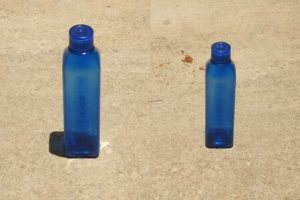New research determines the effects of solar radiation and chemical contamination on plastic chips, and how this affects human cells that are contaminated by these microplastics.
The study was carried out by Vladimir Baulin, from the Department of Chemical Engineering at the Rovira i Virgili University (URV) of Tarragona in Catalonia, Spain, and Jean-Baptiste Fleury, from the University of Saarland in Germany. For the study, the accumulation of plastic pieces on La Pineda beach in Tarragona has been taken as a reference.
The authors of the study found that plastic chips exposed to solar radiation and chemicals are more harmful to human cells than when they have just been manufactured. Although it was known that contact with microplastics altered the functioning of human cells, until now the impact of polymer aging on their properties had not been taken into account. The research has concluded that degraded plastic pieces have a greater capacity to damage cell membranes and that there is a direct relationship between this characteristic and their color.
We call microplastics those plastic particles with a size between one thousandth of a millimeter and half a centimeter, formed by polymers, generally synthesized from petroleum products. They are polluting agents derived from human action, present in almost all ecosystems in the world. Because their size and shape are very heterogeneous, there are always some capable of penetrating the interior of the human body, either through the food chain or through the air we breathe, among other ways.
Previous research, led by Baulin, had already shown that these particles, when coming into contact with cell membranes, have the ability to deform them. More specifically, the authors of that study detected that microplastics stretch the membranes of human red blood cells and reduce their mechanical stability, altering their shape and their ability to transport oxygen. Therefore, even at the cellular level, there are indications that these fragments, once inside the body, have a negative impact on people’s health. Unlike naturally occurring organic particles, microplastics are very resistant to degradation and can accumulate in human tissues indefinitely.
Pieces of plastic on an island beach. (Photo: Susan White/USFWS)
In the new study, Baulin and Fleury have worked with pieces of plastic from La Pineda beach, collected directly from there by the Good Karma Association, to determine if they cause the same damage to cell membranes as newly synthesized plastics. . “These plastics have been in the environment for years, they are affected by solar radiation, erosion, chemicals… and their properties do not have to be the same as when they left the factory or those of the polymers studied in the laboratory,” explains Baulin.
Following a methodology based on microfluidics, which uses tiny droplets to determine the surface properties of materials, the team has managed to relate the level of degradation of the plastic with its level of oxidation. Consequently, the surface of the microplastics that had spent more time in the medium was more hydrophilic, more easily wettable. This is not an innocuous characteristic, especially when the particle comes into contact with a cell. The cell walls adhere to the degraded polymer more easily, therefore causing more severe damage. “The results have confirmed that the more hydrophilic the plastic particle, the stronger the adhesive interaction between the microplastics and the cell membrane,” they conclude. In addition, they also detected that the most degraded plastics adopted a more intense yellowish tone, drawing a relationship between the color of the particles and their potential to damage cells.
“We will continue to investigate the effect of microplastics at the cellular level; We are already designing future research to study how cell membranes behave when they come into contact with synthetic fibers,” predicts Baulin. The main source of fibers that end up in the sea is synthetic clothing, and they are released into the sea through washing machines. Once there, some end up in wildlife and enter the food chain, potentially ending up inside the human body.
The new study is titled “Aging affects the mechanical interaction between microplastics and lipid bilayers.” And it has been published in the academic journal The Journal of Chemical Physics. (Source: Rovira i Virgili University)



![[Img #74662]](https://thelatestnews.world/wp-content/uploads/2024/12/Organisms-with-the-shortest-life-150x150.jpg)







![[Img #74272]](https://thelatestnews.world/wp-content/uploads/2024/11/Degraded-microplastics-are-more-dangerous.jpg)
![[Img #74662]](https://thelatestnews.world/wp-content/uploads/2024/12/Organisms-with-the-shortest-life-300x200.jpg)


Add Comment